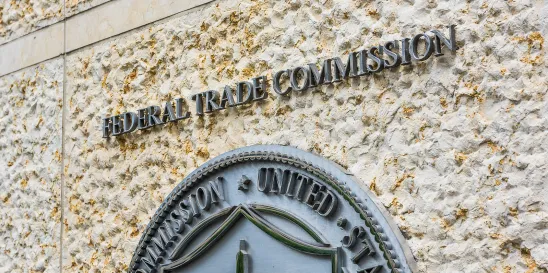On Jan. 22, 2024, the Federal Trade Commission (FTC) approved publication of a notice in the Federal Register that (i) revises the premerger notification thresholds for mergers and acquisitions under the Hart-Scott-Rodino Antitrust Improvements Act of 1976, as amended (HSR Act), and (ii), pursuant to the Merger Filing Fee Modernization Act of 2022 (Fee Modernization Act), revises upward the filing fee tiers and fees within each tier, both of which were first instituted in 2023. Congress first amended the HSR Act in 2000 to require the annual adjustment of notification thresholds based on the change in gross national product (GNP).
The Fee Modernization Act replaced the prior three-tier filing fee system with corresponding size of transaction thresholds with a six-tier filing fee system based on transaction value. As was the case with the prior filing fee tiers, the new tiers set forth below are adjusted annually based on a change in GNP. The fees themselves within each year are also increased annually by an amount equal to the percentage increase in the consumer price index for the most recent fiscal year ended last September over the level so established for the prior fiscal year ending Sept. 30, 2022.
The FTC also published revisions to the thresholds that trigger, under Section 8 of the Clayton Act, a prohibition preventing companies from having interlocking memberships on their corporate boards of directors. These revisions represent the annual adjustment of thresholds based upon changes in the GNP.
Revised HSR Act Thresholds
The initial threshold for a notification under the HSR Act will increase from $111.4 million to $119.5 million. For transactions valued between $119.5 million and $478 million (increased from $445.5 million), the size of the person test will continue to apply. That test will make the transaction reportable only where one party has sales or assets of at least $239 million (increased from $222.7 million), and the other party has sales or assets of at least $23.9 million (increased from $22.3 million). All transactions valued in excess of $478 million are reportable without regard to the size of the parties.
The new thresholds will apply to any transaction that will close on or after the date that is 30 calendar days after the date of official publication in the Federal Register. Official publication is expected in the next few business days.
The following is a summary chart of the threshold adjustments:
| PRIOR THRESHOLD | REVISED THRESHOLD |
|
Size of the transaction test
|
|
| in excess of $111.4 million | in excess of $119.5 million |
|
Size of the person test
|
|
| $22.3 million/$222.7 million | $23.9 million/$239 million |
|
Transaction value above which size of the person test is inapplicable
|
|
| $445.5 million | $478 million |
The amendments will adjust all notification thresholds as follows:
| NOTIFICATION LEVELS | |
| in excess of $50 million | in excess of $119.5 million |
| $100 million | $239 million |
| $500 million | $1,195 million |
| 25% of total outstanding shares worth more than $1 billion |
25% of total outstanding shares worth more than $2,390 million |
| 50% of total outstanding shares worth more than $50 million | 50% of total outstanding shares worth more than $119.5 million |
These notification threshold adjustments also adjust upward thresholds applicable to certain exemptions, such as those involving the acquisition of foreign assets or voting securities of foreign issuers.
Revised HSR Filing Fee Thresholds
Below is the new filing fee schedule, which will apply to any transaction that will close on or after the date that is 30 calendar days after the date of official publication in the Federal Register. Official publication is expected in the next few business days.
| NEW FILING FEE LEVELS | |
| Size-of-Transaction* | Fee** |
| in excess of $119.5 but less than $173.3 million | $30,000 |
| $173.3 million or greater but less than $536.5 million | $105,000 |
| $536.5 million or greater but less than $1.073 billion | $260,000 |
| $1.073 billion of greater but less than $2.146 billion | $415,000 |
| $2.146 billion or greater but less than $5.365 billion | $830,000 |
| $5.365 billion or greater | $2,335,000 |
* Adjusted annually based on GNP.
** Adjusted annually based on the consumer price index (CPI), if the percentage increase in the CPI for the prior year ending September as compared to the CPI for the fiscal year ended Sept. 30, 2022, is greater than 1%.
Revised Section 8 Thresholds
The FTC also published revisions to the thresholds that trigger a prohibition preventing companies from having interlocking memberships on their corporate boards of directors under Section 8 of the Clayton Act. These revised thresholds are effective as of Jan. 22, 2024.
Section 8 prohibits a “person,” which can include a corporation and its representatives, from serving as a director or officer of two “competing” corporations, unless one of the following exemptions applies:
- either corporation has capital, surplus, and undivided profits of less than $48,559,000 (increased from $45,257,000);
- the competitive sales of either corporation are less than $4,855,900 (increased from $4,525,700);
- the competitive sales of either corporation amount to less than 2% of that corporation’s total sales; or
- the competitive sales of each corporation amount to less than 4% of each corporation’s total sales.
“Competitive sales” means “the gross revenues for all products and services sold by one corporation in competition with the other, determined on the basis of annual gross revenues for such products and services in that corporation’s last completed fiscal year.” “Total sales” means “the gross revenues for all products and services sold by one corporation over that corporation’s last completed fiscal year.”



 />i
/>i

